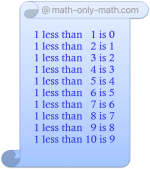Concurrency of Three Lines
We will learn how to find the condition of concurrency of three straight lines.
Definition of Concurrent Lines:
Three or more lines in a plane are said to be concurrent if all of them
pass through the same point.
In the above Fig., since the three lines ℓ, m and n pass through the point O, these are called concurrent lines.
Also, the point O is called the point of concurrence.
Three straight lines are said to be concurrent if they passes through a point i.e., they meet at a point.
Thus, if three lines are concurrent the point of intersection of two lines lies on the third line.
Let the equations of the three concurrent straight lines be
a1 x + b1y + c1 = 0 ……………. (i)
a2 x + b2 y + c2 = 0 ……………. (ii) and
a3 x + b3 y + c3 = 0 ……………. (iii)
Clearly, the point of intersection of the lines (i) and (ii) must be satisfies the third equation.
Suppose the equations (i) and (ii) of two intersecting lines intersect at P(x1, y1).
Then (x1, y1) will satisfy both the equations (i) and (ii).
Therefore, a1x1 + b1y1 + c1 = 0 and
a2x1 + b2y1 + c2 = 0
Solving the above two equations by using the method of cross-multiplication, we get,
x1b1c2−b2c1=y1c1a2−c2a1=1a1b2−a2b1
Therefore, x1 = b1c2−b2c1a1b2−a2b1 and
y1 = c1a2−c2a1a1b2−a2b1, a1b2 - a2b1 ≠ 0
Therefore, the required co-ordinates of the point of intersection of the lines (i) and (ii) are
(b1c2−b2c1a1b2−a2b1, c1a2−c2a1a1b2−a2b1), a1b2 - a2b1 ≠ 0
Since the straight lines (i), (ii) and (ii) are concurrent, hence (x1, y1) must satisfy the equation (iii).
Therefore,
a3x1 + b3y1 + c3 = 0
⇒ a3(b1c2−b2c1a1b2−a2b1) + b3(c1a2−c2a1a1b2−a2b1) + c3 = 0
⇒ a3(b1c2 - b2c1) + b3(c1a2 - c2a1) + c3(a1b2 - a2b1) = 0
⇒ |a1b1c1a2b2c2a3b3c3|=0
This is the required condition of concurrence of three straight lines.
Solved example using the condition of concurrency of three given straight lines:
Show that the lines 2x - 3y + 5 = 0, 3x + 4y - 7 = 0 and 9x - 5y + 8 =0 are concurrent.
Solution:
We know that if the equations of three straight lines a1 x + b1y + c1 = 0, a2 x + b2 y + c2 = 0 and a3 x + b3 y + c3 = 0 are concurrent then
|a1b1c1a2b2c2a3b3c3|=0
The given lines are 2x - 3y + 5 = 0, 3x + 4y - 7 = 0 and 9x - 5y + 8 =0
We have
|2−3534−79−58|
= 2(32 - 35) - (-3)(24 + 63) + 5(-15 - 36)
= 2(-3) + 3(87) + 5(-51)
= - 6 + 261 -255
= 0
Therefore, the given three straight lines are concurrent.
● The Straight Line
- Straight Line
- Slope of a Straight Line
- Slope of a Line through Two Given Points
- Collinearity of Three Points
- Equation of a Line Parallel to x-axis
- Equation of a Line Parallel to y-axis
- Slope-intercept Form
- Point-slope Form
- Straight line in Two-point Form
- Straight Line in Intercept Form
- Straight Line in Normal Form
- General Form into Slope-intercept Form
- General Form into Intercept Form
- General Form into Normal Form
- Point of Intersection of Two Lines
- Concurrency of Three Lines
- Angle between Two Straight Lines
- Condition of Parallelism of Lines
- Equation of a Line Parallel to a Line
- Condition of Perpendicularity of Two Lines
- Equation of a Line Perpendicular to a Line
- Identical Straight Lines
- Position of a Point Relative to a Line
- Distance of a Point from a Straight Line
- Equations of the Bisectors of the Angles between Two Straight Lines
- Bisector of the Angle which Contains the Origin
- Straight Line Formulae
- Problems on Straight Lines
- Word Problems on Straight Lines
- Problems on Slope and Intercept
11 and 12 Grade Math
From Concurrency of Three Lines to HOME PAGE
Didn't find what you were looking for? Or want to know more information about Math Only Math. Use this Google Search to find what you need.
Recent Articles
-
Word Problems on Multiplication and Division of Fractions | Worksheet
Apr 12, 25 03:45 AM
word problems on multiplication and division of fractions -
One More than Numbers upto 10 | Counting One More | Learn 1 more Than
Apr 11, 25 04:09 PM
1 more than means we need to add or count one more number to the given numbers. Here, we will learn counting one more than upto number 10. Examples of counting 1 more than up to number 10 are given as… -
One Less than Numbers upto 10 | Counting One Less | Learn 1 Less Than
Apr 11, 25 04:07 PM
What is one less than? 1 less than means we need to subtract or count one less number of the given numbers. Here, we will learn counting one less than upto number 10. Examples of counting 1 less than… -
Properties of Multiplication and Division of Fractions Worksheet | Ans
Apr 10, 25 03:17 PM
In properties of multiplication and division of fractions worksheet you will get different types of questions based on properties of multiplication of fractional numbers and properties of division of… -
Word Problems on Fraction | Math Fraction Word Problems |Fraction Math
Apr 09, 25 01:44 AM
In word problems on fraction we will solve different types of problems on multiplication of fractional numbers and division of fractional numbers.




New! Comments
Have your say about what you just read! Leave me a comment in the box below. Ask a Question or Answer a Question.